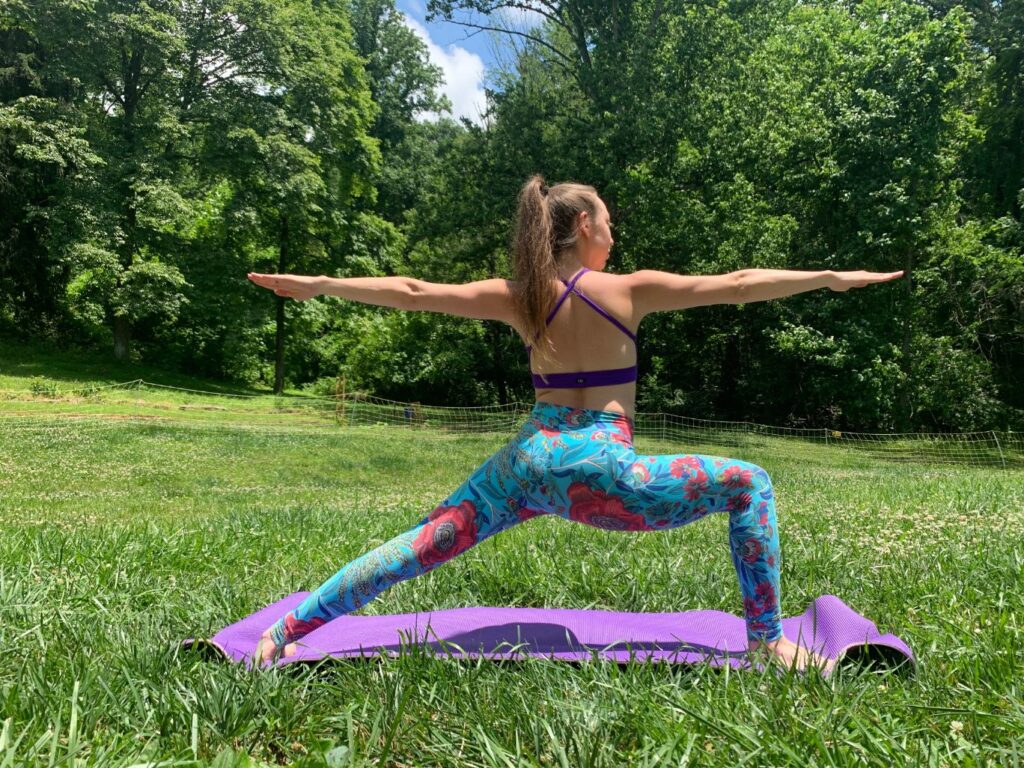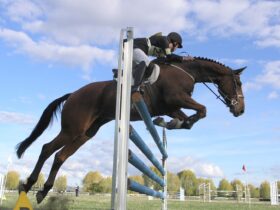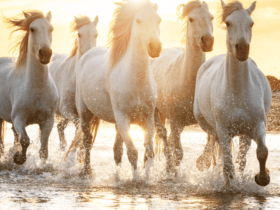—ANGELA NUÑEZ, Certified Yoga Instructor
Yoga has taken the West by storm, and there are plenty of reasons equestrians should incorporate yoga into their weekly routines. As athletes who ride upon living, breathing, feeling beings, it is our responsibility to do everything in our power to ride in a conscious way, so as not to hinder or harm the horse. In our last post, we went over how to do Sun Salutations. Today we’ll cover some of the deep stretching poses that will really increase flexibility, as well as a few balancing and strengthening standing poses.

Virabhadrasana I (Warrior I) builds strength in the core and legs and improves balance. Begin in Tadasana at the top of your mat. Step your left foot back, keeping your feet as wide as your hips. Keep your right foot facing forward and your left forward at a 45-degree angle. Bring your hands onto your hips and square them toward the front of the mat as much as is comfortable. As you inhale, lift your arms up toward the sky with the palms facing in and shoulders relaxed. Keep the core engaged. Press into the outer blade of the left foot to support the ankle, and the inner ball and big toe of the right foot to help you balance. Hold for five to ten slow, deep breaths, then repeat on the other side.

Virabhadrasana II (Warrior II) has similar benefits to Virabhadrasana I, but with slightly different alignment. From the top of your mat, step your left foot back so that the heel of your right foot is in line with the arch of your left foot. The right toes should face the top of the mat, and the left foot should be parallel to the back of the mat. Face your hips and shoulders to the long side of your mat. On an inhalation, lift your arms to the sides with palms facing down, squeezing your shoulder blades in toward each other. Gaze softly over your right fingertips and hold for five to ten breaths; repeat on the other side.

Vrksasana (Tree Pose) improves balance and strengthens the lower body. Begin by grounding through the right leg, keep the right quad engaged and a micro-bend in the right knee. Come onto the toes of the left foot and turn the knee out, keeping the hips facing forward. There are three options for placement of the left foot: the big toe may stay on the mat while the sole of the foot rests on the right ankle; the foot may come to rest on the inside of the right calf; or the foot may come into the right hip crease, or, if this option is too much for the left knee, the foot can rest against the right inner thigh. Bring hands together over heart center. Experiment with lifting arms up overhead and closing eyes to challenge balance as the pose gets easier.


Eka Pada Rajakapotasana (Pigeon Pose) is a deep hip-opener that also stretches the lower back. Begin with the right leg forward and the left leg extending back, palms on the mat. Keep the right foot flexed to protect the knee. Work toward a 90-degree angle in the right leg, but begin with a smaller angle until your hip flexibility increases. Less is more when it comes to the hips! Lengthen the spine and press the crown of the head toward the sky as you inhale, then on an exhalation, begin to fold forward until you reach your edge. If you feel sharp pain or tingling, back off. Deep stretching is good, but sharp pain is a sign that you’re doing too much too fast. Once you reach your edge, hold for five to ten breaths, then repeat on the other side.

Paschimottanasana (Seated Forward Fold) stretches the hamstrings and lower back. Begin seated with your legs together and extending forward. Sit with a long spine, inhale and reach the arms up and out, then exhale and fold forward with a long spine. Be sure not to over-round the back. If your hands do not reach your feet, you may use a strap.

Prasarita Padottanasana (Wide-Legged Seated Forward Fold) stretches the inner thighs and hamstrings. From a seat, take your legs as wide as you can. Keeping an external rotation of the legs, inhale and lengthen the spine, then exhale and fold forward until you reach your edge, holding for a few deep breaths.

Matsyasana (Fish Pose) opens the front body, which tends to round and close sometimes during riding. Lie on your back and bring your palms under your sacrum, keeping your elbows close in by your body. Press into the elbows and forearms to lift your chest. If it’s comfortable for your neck, allow the head to drop back, but keep the weight on your forearms and elbows. Hold for a few breaths, then rest on the back for a few breaths to allow the spine to come back to neutral.
These are just a few poses that will improve your riding. Yoga, like the art of horsemanship, is an ancient, yet ever-evolving practice that you can explore and make your own. Our next posts will cover pranayama (breath work) and additional asana (postures). Until then, keep practicing!
![]() @horse_yoga_girl
@horse_yoga_girl![]() @horseyogagirl
@horseyogagirl
Angela Nuñez-Bowman is a lifelong equestrian and certified yoga instructor specializing in Hatha, Buti, and Horse Yoga. She is sponsored by Horse Tack Company and Equivisor and is a brand ambassador for Outback Trading Company and Goode Rider. Angela has been featured in Horse & Hound, People Magazine, TMZ, Good Morning America, Mashable, Daily Mail, Equestrian Living, Virginia Living, and The Huffington Post. She resides in rural Virginia with her husband, two dogs, and two horses.






















SOCIAL